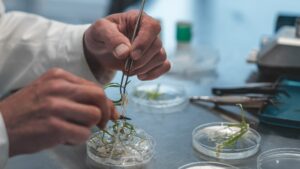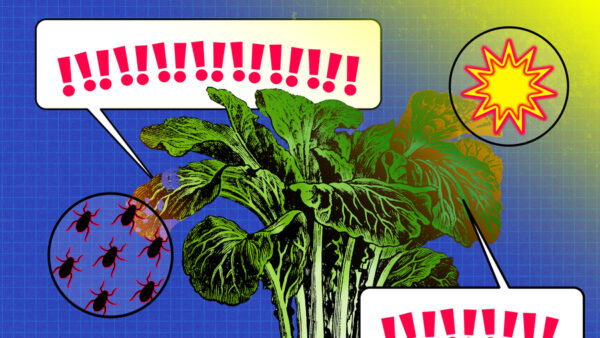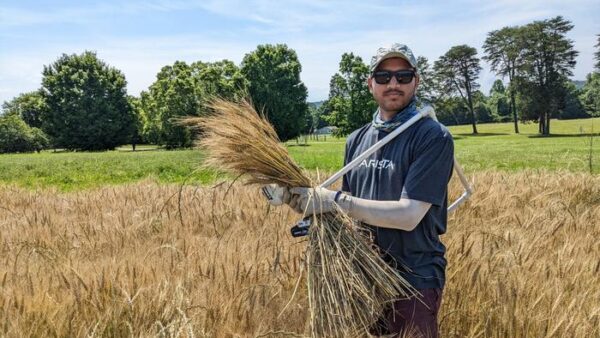
The commercialization of hybrid wheat varieties in Canada is still several years away, but a renewed desire in the private sector to develop improved wheat genetics might mean hybrid wheat will reach the market in the next decade.
Some experts say it is coming in the next decade. Others are more skeptical. But no matter how you look at it, hybrid wheat in Canada is more of a reality now than ever before.
“There’s no doubt industry needs to work together [on cereal research], the reason being when you think about a grower and the farm operation, we’re not going to have the answer to every one of his or her issues,” says Norm Dreger, head of cereals North America for Syngenta.
“We really need to look at the gaps within the offer we have and then look for partnerships and collaborations to try and fill the gaps. This isn’t going to be a cheap, short-term venture to try to ‘technify’ wheat; we’re talking about decades and a great deal of money,” he adds.
Investment is There
The desire to add value and improve the Canadian producer’s toolkit of products has led to an increased investment in wheat in recent years. “When you look at the number of acres out there and you look at the vast array of different types of products that we can produce and produce well in Canada, we’re really just embarking on a whole new frontier in terms of the types of varieties that we can grow and the types of markets that we can access,” says Jeff Reid, general manager of SeCan. “We look at hard white spring wheat for example, now that’s really just getting ramped up in Western Canada and I think those types of things are going to present tremendous opportunity for the seed industry and for farmers across Western Canada.”
While the timeline for new wheat varieties is still somewhat up in the air, one thing is certain: investment will continue and will likely lead to more private and public partnerships. “SeCan has been a fairly large private sector investor in wheat for about the last 15 years, but I think going forward we see increasing opportunity for SeCan to leverage up dollars with other private sector partners as well as the federal government—while they are scaling back their own research and development activities they are willing to partner and certainly look at more partners outside of AAFC,” says Reid.
“In recent years, we’ve heard a lot more about private sector investment in wheat but a lot of that is really still out on the horizon—we haven’t seen a lot of activity on the ground yet at this point and undoubtedly that’s coming and that’s going to be a very positive thing for the entire industry,” adds Reid.
David Hansen, president and CEO of Canterra Seeds, agrees. “Companies are now taking the tools that have been developed for other crops and utilizing them to help advance wheat on a major scale, on a global scale,” he says.
Turning to Hybrids
While many private companies are now investing in wheat, Syngenta is leading the way in Canada when it comes to hybrid wheat research. The company, which invests roughly $130 million annually in cereals R&D efforts globally, announced last November that it was ramping up its hybrid wheat breeding efforts. The company expanded its Junction City, Kan., research site to include an advanced hybrid wheat greenhouse, alongside its North American double haploid lab.
“Nearly a half-billion acres of wheat are grown around the world, but wheat growers are not seeing yield and quality increases in line with other crops like corn and soybeans. We’re working to change that,” said Dreger in a press release.
The company has been breeding cereal varieties for nearly four decades within North America and is now increasing its efforts to release commercially-available hybrid wheat varieties in Canada and the United States. “We’re applying the same principles we used in successfully developing hybrid barley for Europe to develop hybrid wheat varieties for North America,” says Rollie Sears, senior science and technology fellow for Syngenta. “Hybrid wheat can offer growers yield stability and consistent performance across fields with varying soil types and qualities. Our goal is to release the hybrid wheat varieties to growers by the end of the decade.”
Sears leads the research and development operations for cereals seeds and is located in Junction City. His team of seven regionally-based breeders are embedded in research sites across the United States and Canada. Syngenta is also in a partnership with the International Maize and Wheat Improvement Centre that entails joint research and development in native and GM wheat traits, hybrid wheat and the combination of seeds and crop protection to accelerate yield performance.
New Roles for Seed Growers
What will the introduction of some of these exciting new traits and genetics in wheat mean for the traditional seed grower? “Hybridization is certainly a process that results in higher use of certified seed; it results in higher investment or reinvestment in innovation, so all that’s good,” says Dale Adolphe, executive director of the Canadian Seed Growers’ Association. “There is a concern amongst seed growers that when a crop gets hybridized they will lose a role in the production and distribution of that crop kind. And we certainly saw it, as an example, in canola. However, it comes down to the distribution system and wheat is produced differently than canola.”
Adolphe says to seed an acre of canola it takes five pounds, but to seed an acre of wheat it takes about 120 pounds, so companies are going to need local suppliers and distributors as they get into the wheat business.
Reid agrees. “I think going forward the introduction of new traits and genetics will change the landscape somewhat but maybe not as much as people think,” says Reid. “You always hear that saying that ‘wheat is grown, processed and distributed 50 miles at a time.’ And that’s really what sets the cereal industry apart from canola—where canola can be centrally produced and really needs to be because of the costs associated with hybrid seed production, cereals really lend themselves well to localized production, processing and distribution.”
Hansen believes seed growers might even play a more important role in cereal seed production than ever before. “When we look at wheat as a crop it has a very, very low multiplication rate and if we look at the economics and the logistics of growing wheat or cereal seed of any type, moving it from point A to point B is very expensive and very labour intensive,” he says.
“Therefore, we can’t relocate wheat production to another part of the country similar to what we have seen happen in canola, which has a very high multiplication rate. So cereal crops are going to be managed within a hundred- to a fifty-mile radius of where that crop has been produced. Seed growers are the ones that the industry is going to be reliant on to help move the technology, move the traits and move the genetics into the hands of the farm customer,” says Hansen.
“I think it is a message to seed grower retailers that there is an opportunity there to work as a retailer for these private investments in cereals because it’s a different set of logistics than the distribution of canola seed,” says Adolphe. “It’s still going to be local production and distribution of sales.”
Hurdles to Hybridization
While breeders list crop stability and heat tolerance as the main advantages to hybrid wheat, which ultimately leads to more bushels per acre for farmers, there are some hurdles that still need to be met. “Hybrid vigour in wheat to date has been limited to five per cent to a maximum of 15 per cent,” says Ron DePauw, a wheat breeder at Agriculture and Agri-Food Canada’s Semiarid Prairie Agricultural Research Centre in Swift Current, Sask.
Then there is the cost issue. “Production of hybrid seed is very costly. Saved seed from a hybrid will not produce to the same level of productivity as the hybrid and that is an advantage to hybrid seed,” says DePauw, adding that very little to no hybrid wheat breeding is being done in the public sector.
DePauw says figuring out how to get “sufficient hybrid vigour and yield gain to offset the high cost of seed,” are the main factors that might delay the introduction of hybrid wheat.
Darcy Pawlick, Syngenta’s North America industry relations lead, says Syngenta would like to see increased use of certified seed, but he says they understand the benefit has to exceed the cost for growers. “Obviously this would have a benefit to our bottom line and allow us to reinvest back in wheat research, but we believe farmers are smart, dynamic and they understand what’s going on. If there’s a benefit from growing a Syngenta variety, they’ll buy the certified seed because it has the advancement that they’re looking for,” says Pawlik.
That benefit may just be found in Syngenta’s hybrid wheat varieties, he says, adding that the yield benefit of the hybrid varieties may lead more growers to choose certified seed, which in turn, could drive more investment in wheat breeding.
Consumer Acceptance
Hansen says work on hybridization of wheat has been ongoing for many years but trying to perfect a system that will actually work economically on a large field scale has been very challenging. While he says the industry is closer to that end point than where it has been, the introduction of GM wheat is likely still a few years away due to lingering consumer concerns.
“I think we need to talk more about GM wheat, in particular the traits and the values we want to see and in what sort of format they come to the market. There is a lot of sensitivity in terms of public acceptance,” says Hansen. “The technology is certainly available and can be adapted and incorporated into wheat programs relatively quickly for the benefit of the grower, the industry and, ultimately, the end user and consumer but I think we are all well aware that we need to tread carefully. However, I firmly believe that we will see hybrid wheat and GM wheat in certain market segments where it makes sense and where it is not impeding trade and marketing of the commodity.”
The technology is driving acceptance forward, as long as everyone in the value chain continues to communicate and work together. “Society, when you think of consumers, for example, is not only expecting new technology but it is also demanding it because it wants things like sustainability to be addressed,” says Dreger. “Technology acceptance is moving in the right direction but there is a lot of work to be done because there are a lot of players along the value chain and we need to have all of them aligned before we bring the technology forward.”
Julie McNabb
|
Success Story: Hybrid Barley in Europe To date, hybrid wheat has remained a pipe dream. It’s difficult and expensive to produce hybrid seed since wheat flowers self-pollinate. However, hybrid wheat may finally be on the horizon. Syngenta is developing hybrid wheat based on hybrid barley it has commercialized in Europe. Syngenta scientists overcame the seed production issue with hybrid barley using a cytoplasm male sterile hybrid production system. Unlike old attempts to make hybrid barley, no chemicals are used under this system. Instead, this process crosses a sterile female parent with a fertile male parent. The resulting F1 hybrid is fertile and fully restored, and it produces seed across whole barley fields. According to the company, the system for hybrid barley works consistently and Syngenta breeders think it can be transferred into wheat. According to Darcy Pawlick, North America industry relations lead for Syngenta, the hybrid barley system in Europe is: • Driving higher grower ROI (3.3:1) • Giving farmer gains of five per cent premium for quality • Increasing barley yields by up to 20 per cent • More than doubling farm profit per acre in some cases |











